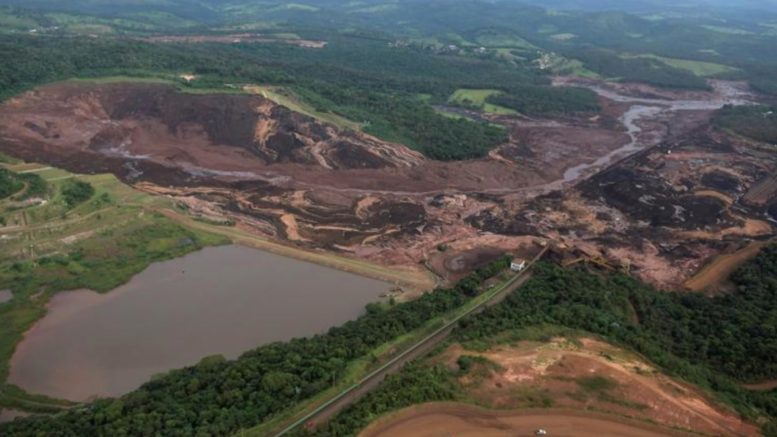Here we go again. With memories still fresh of Vale and BHP’s deadly Samarco iron ore tailings disaster in Mariana, Brazil in November 2015 — which killed 19 people — comes news of a smaller but even more deadly tailings dam collapse at Dam 1 of Vale’s Feijao iron ore mine in Brazil’s Minas Gerais state during the early afternoon of Friday, Jan. 25.
The tailings spilled out with no warning to bury several Vale buildings — including a cafeteria, as employees were eating lunch — and then inundated part of the small southeastern city of Brumadinho.
Dead fish and trash extended more than 18 km downstream from the dam along the banks of the Paraopeba River, where Pataxo indigenous members live, catch fish and draw water for cultivation.
At press time on Jan. 29 — in a story that is evolving by the hour — 84 people were confirmed dead and 276 people were missing in Brazil’s worst-ever environmental disaster. Most of the missing are Vale employees.
The rescue and care of the wounded is happening on-site by the fire department and civil defense, with Vale providing assistance, including 40 ambulances, 800 beds and a helicopter.
The dam was built in 1976 using the “upstream method” by Ferteco Mineracao, which was acquired by Vale in April 2001. The dam was 86 metres high and had a crest length of 720 metres. Its waste disposal area was 249,500 sq. metres and the volume of the spill was 11.7 million cubic metres.
Vale says the tailings dam was inactive, with no tailings being added. There was no pond and no other type of operational activity was in progress. A decommissioning project was also underway.
The dam was heavily monitored by instruments and had been inspected regularly by Vale and the National Mining Agency, including three times in the previous 30 days.
Vale is the world’s largest iron ore producer, with massive operations in Brazil and lucrative exports to China’s steel industry. Its global reach extends to Canada after buying nickel major Inco in the mid-2000s.
In a video posted within hours of the accident, Vale CEO Fabio Schvartsman said: “I have no words to describe my grief, my great sadness, my disappointment with what has just happened. It is something beyond and above anything I could have imagined. I want to express my solidarity and say that Vale will do whatever possible and impossible to help the affected people. It’s something that hurts my soul and also something I never wanted to see in my life … This is inexcusable, but even so, I still apologize to all those affected and to the whole of Brazil.”
Schvartsman has been Vale CEO for only two years, replacing Murilo Ferreira, who was criticized for his handling of the Samarco disaster.
Vale said that at 5:30 a.m. on Sunday, Jan. 27, the warning sirens were triggered at its Dam 6 at the Brumadinho complex after monitoring instruments detected an increase in water levels, and locals were evacuated until waters receded later that day.
By Jan. 29, authorities had detained five people in Sao Paulo and in the state of Minas Gerais in connection with the tailings spill. Three of those arrested worked for Vale, and two worked for German company TUEV Sued, which had inspected the dam. The five will be detained for 30 days while officials investigate possible criminal charges.
The Associated Press reported that in ordering the arrests, Minas Gerais state judge Perla Saliba Brito wrote that the disaster could have been avoided. It’s not believable that “dams of such magnitude, run by one of the largest mining companies in the world, would break suddenly without any indication of vulnerability,” the judge wrote in the decision, according to news portal UOL.
Vale’s American depository shares on the New York Stock Exchange dropped almost 18% to US$11.20 when trading resumed the next Monday, and were up 3% to US$11.48 at press time. Vale has suspended its dividend in the wake of the disaster.
By Jan. 29, Vale had not confirmed why Dam 1 collapsed, but announced it would decommission all 10 of its tailings dams built using the upstream method, all of which are inactive. CEO Schvartsman said this would take three years and cost R$5 billion (US$1.34 billion). Lost production will be made offset by increased production elsewhere.
Vale says to carry out the decommissioning of the upstream dams safely and quickly, Vale will temporarily halt the production of the units where the structures are located, namely: Aboboras, Vargem Grande, Capitao do Mato and Tamandua operations, in the Vargem Grande complex; and the Jangada, Fabrica, Segredo, Joao Pereira and Alto Bandeira operations, in the Paraopeba complex, also including the stoppage of the Fábrica and Vargem Grande pelletizing plants. The operation of the halted units will be resumed as the decommissioning works are completed.
Vale estimates the production stoppage is about 40 million tonnes of iron ore per year, including the pellet feed needed for the production of 11 million tonnes of pellets, an impact that will be offset by the increase in production of other systems of the company.






Be the first to comment on "Editorial: Tailings spill at Feijao is Vale’s worst yet, with 84 dead, 276 missing"